In this 44-page guide, you'll find:
Curious what's inside? Explore the guide's content below before downloading it.
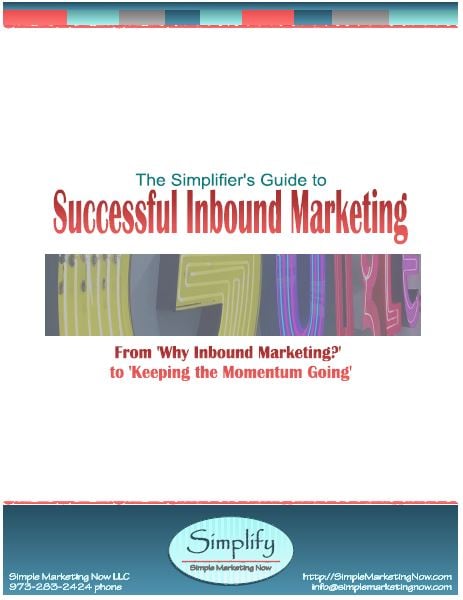
Simply browse and jump to different guide chapters using the table of contents.


Think of all of the things you do on your desktop, laptop, tablet and smart phone... Could you survive without those tools and the access they offer you to information? Same goes for your customers. They use the same tools, when it's convenient to them - whether in the middle of the night, from a different time zone or in your town. Luckily, your website - the digital equivalent of your office, store or showroom - is available 24/7. And if it's fully in sync with your business, it will support and educate your prospects when they begin their due diligence.
The Internet has changed every aspect of the purchase process whether B2B or B2B. We start online and easily complete 75% of our fact finding and decision making before even reaching out to speak or interact with a business representative. Your customers do the same. If they don't come across you online in a search engine such as Google, you don't exist in their world.
All of that marketing and advertising that used to be successful for you - e.g., print or TV advertising, mailings to purchased lists, billboards, cold calls, Yellow Pages - have not only gotten more expensive, they don't help much with searches that start online at a search engine.
That's where successful inbound marketing comes in. It acknowledges that prospects start the purchase process online, finding meaning through search and exploratory research.
.jpg?width=500&name=Googling-twenty20_0032b60c-5525-45f1-9d60-6ecc43abe0dc%20(500x500).jpg)
At the very heart of inbound marketing is drawing visitors to your website by virtue of remarkable content. In other words, being a magnet, rather than an interruptive nuisance that visitors run away from.
Inbound marketing forces you to think intensely about your potential visitors. It gets you to focus on creating web content that is specific to distinct buyer personas, while being aware of the keyword search terms and topics that resonate with them, and figuring out how to offer them valuable information relevant to their stage of the buying cycle.
When you do so and create for truly relevant content for your visitors, they stay longer on your site, they come back for more and - most important - willingly offer up contact information in exchange for your even more valuable content offer. In other words, they become a lead. Once they do, you have the opportunity to nurture the relationship via email by offering additional useful bits of information.
Finally, every step of the way offers data you can analyze for additional insight and improve on what you do.
This type of thinking goes against creating splashy outbound giveaway campaigns that might draw 100s or 1000s of visitors. Once the promotion over, though, they quickly leave never to return. Inbound marketing is for the long haul, for businesses serious about long term and profitable relationships.

Going inbound makes you think about the entire journey your customer takes when doing business with you. When you consider the steps prospects take to become customers, you become aware of their questions and concerns and how to anticipate them with your content. That's how to delight customers for life!
The inbound methodology - visually represented in the graphic below - highlights the life stages of customers as they begin their buying journey, become visitors to your website, leads for your business, customers and then promoters who help you start the process over.
Rather than interrupt and irritate prospective customers, inbound marketing focuses on attracting, converting, closing and delighting.
Throughout the inbound marketing process, you analyze your marketing activities on an ongoing basis to understand what works and what doesn't so you can continuously improve.

Inbound marketing is disciplined and data driven. It encourages you to be deliberate and thoughtful about what you intend so you can measure results and evaluate success.
An essential tool is the setting of SMART goals. SMART stands for goals that are Specific, Measurable, Achievable, Relevant and Time-specific. For example,
If you need to generate $X in revenue for your business by a certain date, you'll start to consider the different website marketing levers you have available to increase traffic, generate leads and convert prospects and put a plan together for delivering on that goal. You'll look not only at web traffic and web sources, but also conversion rates and the quality of that traffic.
From there, you can decide whether you need to generate more quality blog content, better offers, convincing lead nurturing emails and/or better follow up, and which A/B tests to run.
Think of yourself as in a constant state of continuous improvement to deliver better experiences for your customers.
Ultimately, inbound marketing is about creating marketing that customers love. The only way that can happen is if you focus intensely on your customers - what makes them unique, why they buy from you, how your solutions can help them, what their buyer journey is, what words they use to describe their issues, what their questions and concerns are.
Be your customers' champion. Ensure everyone in your organization understands your core customer personas and how you provide them with value. Without customers, your business has no reason for being.

Ultimately, embracing inbound means that you stay focused on your business goals. The inbound methodology provides you with a framework for harnessing digital tools for your business so you can evaluate and test how they deliver on your SMART goals. So, even if you go down a rabbit hole chasing pretty pictures on Facebook or Pinterest, you'll find yourself stepping back and asking yourself how you can apply what you've observed to your own social content or how to improve it. If you can't, you'll try something else.
Getting found online is not a quick fix. It's an ongoing process, a marathon of sorts. It involves frequent and consistent content, keyword research, content optimization and analysis. The more you stay focused, work hard and stay smart, the more you'll enjoy the journey. So will your customers.

To do inbound marketing, you need:
Let's explore each one.

Critical to your business is having a content machine you control.
A content machine starts with your company website, and - ideally - includes a blog. That's your business' digital printing press or publishing platform. We'll discuss blogging separately in this chapter.
The company website has evolved considerably over the years. Whereas it used to be more of a static brochure that you could forget about once published, it is now a living entity and the digital 24/7 equivalent of your sales/marketing organization and physical location. It's available when your prospective customers want to learn about you, not when you have business hours.
As a living entity, you need to actively manage it. To do so, you must have control of it. That means that you:
When you actively manage your website, you keep it fresh and free of digital cobwebs. You make sure the content is up-to-date, and ensure that each page has been optimized for searchers and search engines. Each page should have its own unique title and meta description (that's what shows up in search results) and include plenty of content that educates about your company and the solutions you provide. More specifically,
Page title: 70 characters
Meta description: 150 characters
Tip - Make a habit of 'walking' through your site, as if it were a physical location. Pay attention to what's there. Is it accurate or out-of-date? Do you notice any strange content that makes no sense for your customers or business? Is anything broken?
.jpg?width=500&name=Printing-Press-twenty20_4849f6c6-37c0-4c0c-bdfc-f7536c63dc52%20(650x456).jpg)
Your content machine should include a business blog.
Why? Because a business blog is the equivalent of a printing press for your business.
Every time you publish an article, you create a new page associated with your website and you send a signal to search engines that your site is active with fresh content. Each article allows you to develop a topic related to your business and of interest to your prospects.
Furthermore, a business blog allows you to:
1. Educate your prospects. Educating is far more powerful, more trustworthy and more relevant to website visitors than pure selling or even traditional marketing content. Education means that you can anticipate the questions customers may have and that you understand who they are.
2. Answer commonly asked questions so you only have to respond once. You can then easily refer to the response with a link in follow up communications. This can be particularly valuable for customer service and sales associates who are frequently responsible for answering customer questions.
3. Build out FAQs. Let's say the FAQ section on your website includes a list of commonly asked questions with short answers. You can take each FAQ and turn it into an in-depth article with pictures, diagrams and videos. You can then add a link to your blog article in the FAQs so visitors can get more information about the topics they are researching. If you have no FAQs on your site, this is your opportunity to start developing that section.
4. Hyper focus on a keyword topic and/or longtail keyword relevant to your business and of interest to your prospects. Go in-depth, be unique and thorough, add valuable resources and make the blog article truly remarkable in addressing the topic. The beauty is that it will generate traffic to your business consistently over time.
5. Repurpose blog content into an ebook offer to help your business generate email leads or into a pillar page such as this one.
6. Show your passion for your business and category. Passion is contagious; it differentiates you. It's human, and people like to do business with humans.
7. Demonstrate trustworthiness by virtue of publishing regularly (i.e., at least once per week) and consistently over time (because this is how you do business). Combine that with passion and the willingness to interact with readers via comments or email exchanges, and you create a powerful testament to the character of your business.
8. Significantly increase the number of opportunities your business has for appearing in search results because each blog article you publish is a separate page on your website that can be indexed by search engines.
9. Attract organic traffic to your site. These are new visitors who are finding you because of your content and not because they are searching directly for your business and your company name. In so doing, you are expanding the circle of awareness and opportunity for your business.

10. Be more conversational than on your website pages.
11. Link to relevant content found deeper within your site. That way, you introduce visitors to the products and solutions available on your site.
12. Attract links from other online sources because your content is highly educational and informative. These links are desirable when they come reputable sources; they indicate that your content has authority and is worth directing traffic to.
13. Have legitimate material to share on social networks. And, if your content is truly remarkable, your social network will willingly help share and promote it.
14. Be a thought-leader in your industry.
15. Embed videos or slide presentations in blog articles. You create a content hub for your business that associates can use in day-to-day business interactions and in follow-up emails.
16. Share articles in email newsletters. This gives you a broader message to share, one other than 'buy now' and means that you are relevant across all phases of the buying process.
17. Promote a content offer at the end of each article, thereby converting visitors into leads.
18. Bring to life your company mission statement, expressing what you believe in, what makes you different, and what your business is about.
19. Highlight those who help make your business a success - customers, suppliers, associates, related businesses. When you make others shine, they have reason to go out of their way to help you shine.
20. Test out marketing campaigns.
With all those benefits, though, comes responsibility.
.jpg?width=500&name=Fish-Net-twenty20_32921d08-521e-4400-9d0b-674a7e39ea8a%20(650x488).jpg)
As your valuable 24/7 digital sales & marketing assistant, your website needs to perform as a business asset. In other words, it needs to help you collect contact information - and especially email addresses - so you can follow up with prospective customers.
For those who are ready to do business with you, you'll want a 'contact us' form where a visitor can include detailed pertinent information for immediate follow up.
However, not everyone coming to your website is ready to buy and you don't want to turn those people away. Those people are doing their due diligence. By the time a potential customer actually reaches out to a person in your organization, 70% of the decision-making process will already have taken place. So you need your website to be that silent resource working on your behalf educating and also capturing lead email addresses for further nurturing.
To do that, you need tools:
At a bare minimum, you can use an email signup form.
Ideally, though, you have a means of delivering a content offer in exchange for the email address, and asking questions to help you qualify the prospect. Here are two options.
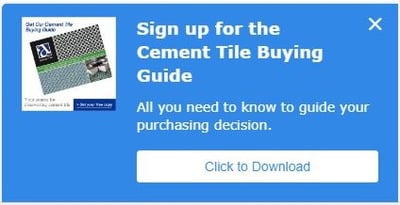
This tool is simple yet effective especially when combined with behavior on the page (i.e., it appears after your visitor spends time exploring). You can include a visual of the offer, as well as a compelling headline and space to explain how the offer delivers value.
When the visitor clicks, one to four form fields appear where you can ask for an email address and some additional information.
Once the form completed, the visitor can access the offer via a link on a 'thank you' message.
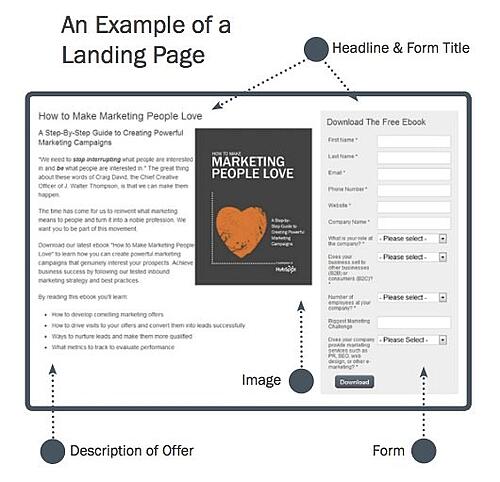
A landing page is a web page deliberately created to help you convert visitors to your site into leads because it provides you with the means for capturing an email address. A formal landing page includes several elements:
A page completely focused on the offer. Even website navigation gets removed so as not to distract from the offer.
A compelling headline and space to explain how the offer delivers sufficient value that a visitor would agree to leave an email address and other information. Include bullets to detail benefits.
An image showing what the offer looks like.
A form for capturing an email address, and as relevant more information (name, company name, persona qualification question, business questions...)
A means for delivering the offer - aka the 'thank you' page
The 'thank you' page completes the landing page experience. It's a separate web page that appears after you complete the form and click on the Download button. It delivers the offer you are promising and restores navigation to the rest of your website.
The benefit to this more formal experience (compared to the popup leadflow thank you message) is two-fold:
An offer can be an ebook, a checklist, a bundle of delicious and relevant information consisting of links and downloads...
The offer must be of interest to your ideal customer (aka persona) and relate to the stage of the buying cycle s/he is in.
Generally, when a prospect is at the early stages (e.g., awareness), the offer will be more educational and relate to research on options available. Further down the buying journey (e.g., interest and decision), the offer will be more focused on buying criteria and the decision-making process.
.jpg?width=500&name=Rolodex-twenty20_bd3c9b7a-a9fa-4eea-ba9e-7392e625a66b%20(562x700).jpg)
A contacts database is the digital equivalent of a Rolodex where you can easily search to find specific contacts, track notes and information about a contact and - ideally - monitor the contact's behavior on your website. For example, has that person downloaded an offer, read your emails, visited your website multiple times.
Another name for a contacts database is a CRM - a customer relationship management tool.
The popup tool described above integrates with a powerful free CRM as well as an email tool such as MailChimp. The landing page tool above integrates with a marketing contacts database as well as a CRM. Both are from HubSpot and include:
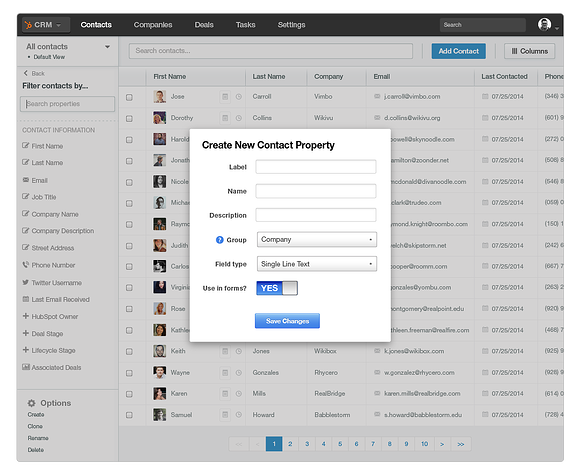
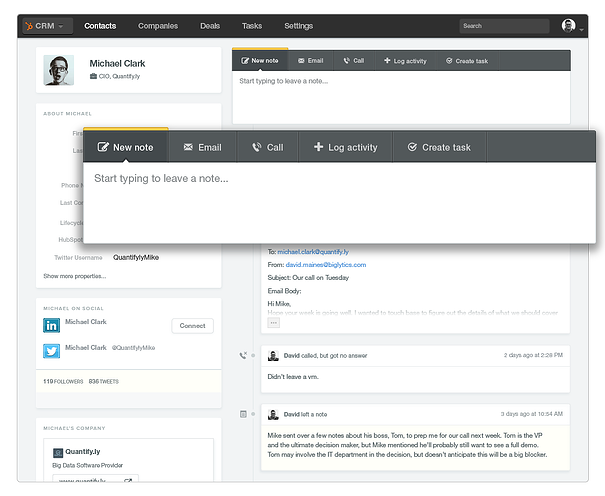
The benefit of a contacts database is that it allows you to keep track, organize and methodically manage the leads that your business generates.
.jpg?width=500&name=Love-letter-twenty20_3b204bfd-e861-4fdf-bab5-1b313fa72270%20(650x515).jpg)
Email is powerful, especially if you use it responsibly and with permission. Don't let anyone tell you that it's obsolete. It's not.
Email marketing allows you to develop a direct connection and an ongoing relationship with potential customers. It enables you to demonstrate intense respect for your customers so that they welcome and treasure your messages.
It starts when you obtain an email address and permission to communicate using the tools described above. Then, you can begin the lead nurturing process via a sequence of email messages sent manually or via automated email workflows.
During lead nurturing, you get to learn more about your lead - including where s/he is in the buying process - and your lead learns more about you, your organization and the solutions you provide. You can expose your lead to your thought leadership, examples of your problem solving and start providing information and education about problems your lead may be facing. You can also direct or guide your lead to specific parts of your website and to additional offers. Lead nurturing plays an important role in converting an interested and qualified lead into a customer.
However, you need to craft messages that your recipients will welcome.
Your email resource needs to integrate with your contacts database either as an integral part of it (e.g., via HubSpot) or through API integrations with tools such as MailChimp. You do not want to use Outlook or Gmail. Instead, you want a tool that allows you to send out professional emails and tracks results (e.g., opens, clicks, unsubscribes, etc.).
.jpg?width=500&name=Social-Drawing-twenty20_4a0ad8e6-9d20-4a6c-b5fd-6974b8da84fa%20(600x400).jpg)
Whether your blog content management system auto-publishes to your top social networks, or you manually update your networks when you have new contents or updates to share, it's important to plan ahead and develop a system for consistently sharing content on social networks.
Don't overlook social networks. They can help you amplify your messages, plus chances are that you'll be surprised by the vibrant communities you may become part of.
.jpg?width=500&name=Dashboard-twenty20_8892c947-f097-47f9-a922-a440782bb43c%20(650x433).jpg)
Analytics matter. They help you evaluate progress against your SMART goals and tell you whether you're generating results that can benefit your business. If you don't have website analytics installed on your site, you need to do so. At the very least ensure Google Analytics is in place. Ideally, your marketing automation software will also provide you with data.
(If you aren't sure if you have Google Analytics installed or not, there's an easy way to check. Go to your website and right click; select 'view source' which will open up a new page where you'll notice lots of code. Click {control} F (or {command} F on a Mac) and type in "Google." If it's installed, you'll find it highlighted.)
The paradox of digital marketing is that is delivers data. Lots of data. The challenge is making meaning from the data so your business can benefit.
To that end, be consistently rigorous about reviewing your analytical data on a regular basis. At a minimum on a monthly basis. You'll find it valuable to use the information as a basis for actions.
Look at your new offers and blog content to determine what resonates. Determine how to test timing and types of content to share on social networks. Be sure, too, to compare your online analytical data to your business dynamics. If your website is the digital equivalent of your business/office, it needs to support your sales and marketing programs. If it isn't, you may be missing opportunities.
You've identified the tools you need for inbound marketing. How do you get started? In this chapter, we'll discuss next steps. More specifically,

Assess where you are. Conduct an audit of your online and offline content.
Review how well your website is performing from an organic search perspective. Which are your top pages and blog articles? Which keywords matter most to your business?
Have you identified distinct personas for your business? How does one differ from the other? How does each progress through the buying cycle?
What questions do your personas/prospects have about the solutions you provide? Have you integrated those questions and words into your content (i.e., into your keywords.) and matched that content to your buyers' purchase process?
How are you currently attracting visitors to your business and website? Think about in-person activities as well as what you do online. Do you use a blog? Have you developed ebooks and offers that prospects have told you are helpful? Which professional and social networks do you find most valuable? Do you have Calls-to-Action (CTAs) throughout your website and on blog articles?
How are you converting prospects into customers? How do you communicate with prospects and customers over time? Have you created lead nurturing workflows? Do you use marketing automation? Do you send out regular email newsletters?
How do you delight customers? How do you maintain customer relationships? What role do social networks play and how involved are you?
What role does your website play in educating prospects? How do you update web content and how frequently?
What tools do you have available to analyze, optimize and stay focused on what's important to your business online? Are you examining your site's analytics, email marketing stats, blog stats, keyword progress and other data programmatically to determine how well all of these help you convert visitors into leads and customers? Do you regularly conduct A/B tests?
What content tools do you already have available? When you explore how you currently interact with customers, you'll most probably discover a treasure trove of material - much of which may be sitting in file cabinets. With inbound marketing, you can put those content assets to use online so your website truly functions as a silent sales and marketing assistant, available 24/7 at the convenience of your prospective customers, educating them and guiding them until they are ready to become your customer. Inbound Marketing helps you build trust as you generate leads.
.jpg?width=500&name=Keys-change-twenty20_29c069be-c5f3-44f2-84d8-1ef50df63768%20(650x488).jpg)
In the digital world, keyword topics are critical. They define our business, the solutions we offer and our relevance to potential customers. They unlock meaning!
Keywords affect our ability to get found online. The right ones can be elusive, especially if the solution offered represents a problem prospects may not realize they have, let alone search for on an ongoing basis.
Once identified, keywords become a beacon for conversation, website content, Twitter and LinkedIn profiles and blog updates. They become measurable and the basis for ongoing improvement. Keywords bring meaning to digital and social marketing.
And, yet, keywords and keyword topics can be confusing.
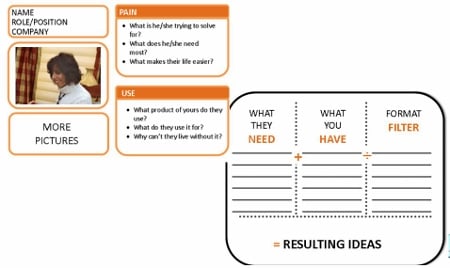
Developing a buyer persona is good business. It's also a valuable exercise for everyone in your organization to participate in.
It's a valuable process for a business, particularly for an effective inbound marketing strategy, to create content that resonates with prospective business customers, and for guiding your social media marketing engagement. Personas are semi-fictional representations of customers that you create for your business based on understanding (and researching) different groupings of customers and detailing their roles, pain points, professional interests and questions. Ideally, you name them and associate a picture of a person with them so you readily visualize them as legitimate entities as you develop marketing materials and make business decisions.
Once you have developed your buyer personas and tested them out, you may be ready to fine tune them with more data from your analytics.

Do you think much about your buyer's purchase process aka their buying cycle? It's sometimes referred to as the sales funnel, too. What's important to realize is that:
Not every visitor to your website is ready to buy from you. Neither is every person entering your store, showroom or office. Just because someone isn't ready to buy doesn't mean that you shouldn't connect and start to build a relationship.
The best way to start building a relationship is by offering information that educates a prospect. Once educated, a prospect can appreciate the evidence of your expertise
The job isn't over when your prospect makes a purchase.
You can address your buyer's purchase process with your website content, your blog content and your content offers.
At the very top of the funnel, once a prospect has become aware of a need and has established interest, consider articles and blog posts about industry trends, product neutral information. Focus on how to educate. Can you create a check list, a white paper, a buyers' guide to help him/her make sense of the category and the options available? This content focuses on the Where, What, When, Why and How related to the problems that prospects are trying to solve.
Mid-funnel is when you can offer content that helps prospects understand the different options and solutions available to their issues. Not only can you compare options, address industry trends, methodology, and strategic insights, but you can also highlight your expertise: webinars demonstrating successes, free trials, demonstrations, case studies... In the process, you help your prospects get closer to the bottom of the funnel and decision-making. Here, you want to highlight that you offer more perspective than just a project.
At your prospect progresses toward the bottom of the funnel, you may want to offer evidence of your competence to help your prospect become a customer. For example, specific product or service comparisons, customer stories, evidence of your credibility and strong reputation, product sheets, one-on-one consultations, and eventually pricing for a specific solution. Focus on building trust since ultimately people want to buy from people they can trust.
Listen carefully to current prospects and customers - online and in real life. You'll notice differences in how they refer to your product or service depending on which stage of the buyer purchase process they find themselves, and also depending on which buyer persona is interacting with your organization.

Creating online content is work. You need to keep it fresh. You need to put some thought into it. If you're publishing a blog, you need to strategize and plan so you have content ready to publish regularly and consistently.
Realize that your digital content is the most powerful means a business has for connecting with customers. It's more permanent than a magazine advertisement. It works 24/7 on your behalf. It supports your offline activities. It increases your efficiency by enabling you to capture commonly asked questions and share answers and resources that prospects can access when they aren't ready or willing to speak with you.
The best way to be successful is to manage the process, keep a content calendar and hold regular content strategy sessions to discuss:
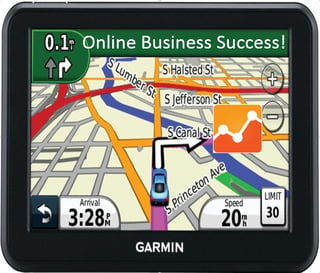
Content strategy planning works best when you review how your previous content has performed.
What worked well? What generated the leads you were hoping for? How well qualified are sales leads? Do you need to nurture contacts longer? Do you need more or different offers?
Did you run some A/B tests? How did those perform? What did you learn?
Always for reviewing and asking questions so you can build off of what you've learned and deliver even better results for your business. It's an on-going, iterative process.
In this section, let's explore some common mistakes associated with inbound marketing. Now, mistakes may be too strong a word. Because if you aren't encountering some of these situations, you may not be sufficiently inboundy in your marketing, or you may be focusing in one direction at the expense of another, or you've successfully addressed one goal and are ready to tackle the next one.
Consider this then a checklist to review every so often so you can confirm that you're addressing the big inbound marketing picture for your business. I've organized it in the following categories (have you noticed the theme?):
.jpg?width=500&name=Art-Mess-Mistakes-twenty20_81859570-e59b-4bb7-b948-f660c0092991%20(500x333).jpg)
Successful inbound marketing depends on regularly producing content to attract traffic to your site. To that end, check that you are:
1. Publishing consistently on your blog. Develop a schedule and stick to it.
2. Publishing articles that are not too short, of high quality and of interest to your buyer personas. Do your homework; figure out the keyword topics of relevance that you can rank for and develop the best quality long form content you can that your prospects will appreciate.
3. Including images, headers, subheaders, bullets and white space to make your content easy to scan and consume, even on mobile devices.
4. Including a Call-to-action in your blog posts; adding links to relevant articles and content deeper in your site.
5. Doing your SEO homework. I.e., taking care of the basics on your site. Create unique and concise descriptions about your business for each web page and blog article; focus on keywords or topics that are meaningful, rather than generic. Instead of 'case studies,' talk about 'inbound marketing case studies.'
6. Regularly reviewing your website for freshness.
7. Remembering that not everyone coming to your site is ready to buy! Develop interesting offers for the different stages of your persona's buying cycle. Be aware of how each talks about the problems you can help them with.
8. Be curious about who visits your site, what those people do on your site, what content they prefer and what questions they ask you. If you discover they represent the wrong traffic for your business, do something about that.
9. Use data from your site to ensure that your website is working hard on behalf of your business. If you're getting a lot of traffic and none of it is converting, develop a better offer. If you aren't generating enough traffic, review whether you need to develop deeper content, increase your publishing frequency or both. Track your goals and use that data to improve your results.
10. Checking yourself and your important search terms on Google every so often. See what comes up; see what is relevant to you. Think how you might incorporate more relevant keywords and topics so you have a chance to get found online. Remember that our own company name and products aren't ideal terms to focus on for organic keywords. Typically, people searching on those terms know you already. Ideally, you want to connect with customers who don't yet know about you, who are still figuring out what kinds of solutions are possible.
11. Confirming that your content strategy includes social media and that you regularly share your content (and interact, too!).
.jpg?width=500&name=Traffic-twenty20_68e11dd3-047a-4f48-b48e-5ef9ffba0dde%20(500x333).jpg)
Successful inbound marketing depends on regularly converting that traffic into leads. You do so with content offers that interested prospects can sign up for. To that end, check that you are:
1. Creating a frictionless path between Call-to-Action buttons, landing pages and offers. Friction generates a sense of unease or lack of trust in what you offer. Make sure that the words used in the link or the call-to-action button relate to those used in the landing page title and copy. Make it easy.
2. Clear, concise and upfront in your value proposition, and also consistent. Make sure your creative supports the goal of the page. If you aren't sure, conduct an A/B test.
3. Short and sweet and to the point in your landing page. Be compelling in your page header. Use bullets to highlight benefits and stay focused on your goal: to convince your prospect to download your offer.
4. Supporting the purpose of your landing page: to convince your visitor that your offer is worth completing a form and sharing an email address and possibly other information. That means that the page includes no navigation, no menu options which might offer distractions and an alternate path through your site which bypasses the offer.
5. Sure that regardless your visitor's digital environment - desktop, tablet or mobile - your landing page can be easily accessed.
6. Deliberate about the information requested on your landing page form. Evaluate your offer and determine which is the best form to combine it with. Form fields help you qualify leads. Generally, the fewer the fields the greater the number of form completions and the less qualified the entries.
7. Customizing your form submission button to say something other than "submit." Go for buttons that say 'click here to download' at a minimum or are even more descriptive. Your prospects will appreciate it!
8. Optimizing Your Landing Page. You probably want your landing page to get found in search results so make sure you have a descriptive page title, a meta description that is relevant not to mention copy that is keyword rich and meaningful to other similar prospects.
9. Comfortable that you have enough relevant offers based on your personas' buying stages to create compelling campaigns and nurturing email sequences.
.jpg?width=500&name=Love-Customers-twenty20_5ecc5c61-10af-451c-b5cb-e7743199e8c6%20(500x375).jpg)
With successful inbound marketing, you expect to close qualified leads into customers. To that end, check that you are:
1. Qualifying your prospects.
2. Aware what makes for a sales qualified lead. Work with your sales team to understand which are critical characteristics that marketing needs to be considering and addressing to ensure that a prospect is marketing qualified. Do you need different blog content? Do you need new or different offers? Do you need to ask additional questions on your forms?
3. Regularly communicating with your contacts. It's important that they be hearing from you regularly and consistently over time via monthly emails and/or nurturing email workflow campaigns.
4. Reviewing your contacts database and/or CRM to ensure that the quality is good. Regularly purge invalid emails; requalify inactive ones. Use lists to segment your database into like groups to make for more relevant communications.
5. Comfortable with the SMART goals you've set for closing customers - and have enough traffic and leads to convert in your pipeline.
6. Coordinating with sales so they are reaching out to qualified leads for a conversation.
7. Encouraging sales to make use of marketing intelligence that shows how leads interact with your website and your content.
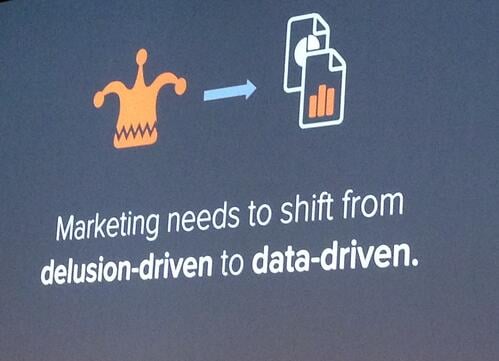
Successful inbound marketing is data-driven and practical. If it doesn't benefit your business, you need to rethink your strategy and your priorities.
"If you are running an inbound marketing program and not tracking ROI, you are doing your company – and your career – a disservice because inbound marketers who measure ROI are more than 12 times more likely to be generating a greater as opposed to lower year-over-year return."
To that end, check that you are:
1. Identifying ahead of time expectations for your investments (e.g., visits to your website, download of an offer, time spent on site, increased engagement, ecommerce sales, etc) so you have a better chance of achieving some of your goals. This also helps with prioritizing.
2. Regularly Testing to determine what you might improve. This includes emails, landing pages, Paid Search ads, blog article titles, types of offers, etc.
3. Never getting too comfortable. Stay humble and curious so you can always learn and improve.
By now, you realize that great content matters intensely for your website and business blog, and publishing regularly and consistently over time is a priority. As easy as that is to say, feeding the content machine can feel overwhelming once the routine sets in if you don't have a process in place. So let's talk about how to keep the content momentum and magic going.
In this section, we'll cover:

As with any editorial or content-based mission statement process, you'll want to start with your audience. In other words, the "Who."
Then, explore "How" you plan to reach the "Who."
Identify the "What's In It" for the "Who" and you.
Finally, be sure to understand the "Where" of your competitive environment.
The most critical part of your purpose is understand who you are trying to reach with your business content. When you do, you generate traffic which can then lead to subscribers, leads and even prospective customers.
When you consider the 'how' of your blog, you are thinking about the content itself, in other words the voice of your blog, your content topic buckets and the different formats of the article, as well as the business blogging process that helps you stay on track and on schedule.
Will your blog be casual or formal? Will you be open to questions and comments or only state facts? Will you use first person, second person or third-person only? Will you focus on educating? On entertaining? On being scientific?
Determine what's right for your audience and your business. You may have several depending on who contributes to your blog.
Identify broad topics buckets that relate to your business and you are expert in, and that are of interest to your audience. Don't go crazy and try to be all things to all people!
If you need inspiration, think how your favorite magazines organize themselves and notice their common topic buckets. If there are similar ones in a same space, look at how one differentiates itself from the other. For example, Fast Company is one of many business-focused publications. It differs by focusing on creativity and innovation.
What formats will your content take? Certain topic buckets may naturally fall into a specific format. For example, a topic focused on 'voices of the industry' might consist only of blog interviews. Another might be about explaining difficult industry concepts with lots of visuals or video, such as Rand Fishkin's Whiteboard Friday series.
It's a good idea to have several formats you're comfortable with for your blog for variety and interest.
A business blog is particularly effective at generating traffic by virtue of regular and consistent publishing. That means having a schedule and sticking to it, just as a daily newspaper, a weekly digest or monthly publication does.
Winging it goes so far. You want to avoid burnout. Best, then, to have a content calendar whereby you identify ahead of time topics to cover, specific articles to develop and due dates for delivery.
Remember to amplify each article once it is live through distribution to social media outlets, as well as in your own email and other business communication tools.
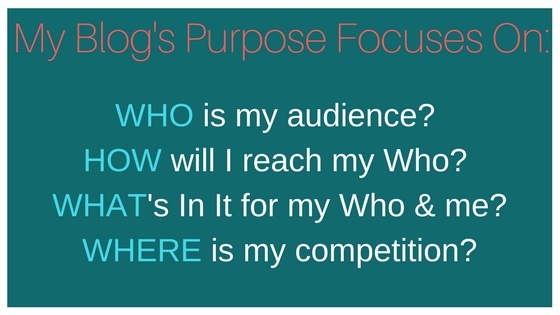
Your audience has plenty of other options besides reading your blog article. What benefits will they gain from your content? How will you help them?
Since you're doing this for your business, you have to think about what you want from them... Yes, you'd like them to read your content. But, what else?
If what you offer them is of sufficient value, you may receive what you want from them.
When you're getting started with a blog, it can be overwhelming to think about who else is out there writing competitive content. At the same time, it's both humbling and grounding to do research on the keywords and topics that you intend to focus on.
None of this means you shouldn't launch your business blog. It will affect, though, affect your purpose.
So, research your keywords and topics. Find out who else is writing about them and how authoritative their sites are. Get creative about how to make your content more relevant to your audience and your site more authoritative about your subject matter.

During these regular content strategy sessions, you can review what is generating success, what isn't, and what your next business content priorities are. Then, brainstorm your next content ideas:
You may want to create a formal process for tracking ideas, due dates, assets needed (including offers) and project owners. Options include an Excel spreadsheet, project trackers such as Smartsheets, Teamwork, Asana and many others.
Have fun with these sessions and be open to possibilities.
As important as it is to use your website and blog content to attract traffic organically to your site, it's worth considering paid search and paid social.
Paid Search - aka PPC, pay-per-click, using Google Adwords or even Bing - can be valuable for testing out keywords and ideas, how well an offer converts on your site, for example, as well as to jump start traffic to your website. The same holds for paid social ads and promotions, especially since as social networks become profitable, they tend to diminish organic visibility in favor of paid.
For paid social search, you'll want to consider the networks most relevant to your personas - whether that's LinkedIn, Facebook, Pinterest, Instagram or others.
The beauty, though, of both paid search and paid social is that you can drill down geographically as well as demographically and obtain valuable marketing insights.

From an inbound marketing perspective, relying entirely on paid traffic to your website doesn't make sense long term. Much better to focus those resources on publishing blog articles and developing deeper content offers (say a guide or an ebook), and using paid programs strategically to strengthen those efforts.
If you are considering paid search for your business, here are 17 tips for getting started.
1. Identify a goal for doing paid search and social. Is this a short term test? Are you looking to generate paid customers? Determine why so you can track how successful paid search and social are for your business.
2. Take care of all of the website basics that you can from an organic perspective. That means taking care of website copy, tags, meta data, and content.
3. Research your competition. Use the Google Adwords search tool to explore ideas. Check out your competitors' websites. Do searches on Google in incognito mode on terms relevant to you and see who comes up in results, including paid results. Observe how competitors position themselves in their ads, how far up in results they appear and whether they also appear organically in results. Do the same on social networks.
These next tips focus on paid search.
4. Pick relevant keywords (and variations) to focus on in your paid search campaign. Be as narrow and specific as possible. As you did when exploring organic search terms for your website and blog, focus on keywords relevant to your business and to customers seeking solutions to problems you can help them with.
5. Be specific with the keywords you bid on. If you aren't, you'll wind up paying lots of money to attract unqualified or irrelevant traffic. For example, rather than bid on "case studies" which is generic, opt for "inbound marketing case studies" if inbound marketing is your area of focus and you intend to promote inbound marketing case studies on paid search which will attract prospects looking for inbound marketing case studies.
6. Create a Google Adwords account (you'll need a gmail account just as with Google Analytics; you can even link up your Google Analytics account). Create a campaign; within your campaign, create an Ad group. Identify the keywords to bid on and create and ad (consider creating a second variation so you can test which one does better). Note that ads have word count limits and other constraints (e.g., no all caps).
7. Focus entirely on the Search Network rather than the Display Network (i.e., showing up in blog and other website ad listings), especially when you get started with paid search. If you do advertise on the Display Network, create a separate campaign as the dynamics are radically different.
8. Start with a low budget ($5-10/day for example) so you can experiment, establish a baseline for bids and traffic and be able to understand what the results of your paid search campaign mean. Once you get a feel for the dynamics for your campaign, you can consider increasing your budget as long as you stay focused on the goals of your paid search campaign.
9. Consider organizing paid search campaigns around your products, services and offerings. Within one campaign, you can create several ad groups which each relate to a common category. If you sell fishing products, create a campaign around fishing rods and distinct ad groups around kids fishing rods vs. deep sea fishing rods.
10. Experiment with your ads on an ongoing basis until you find the right combination of benefits which result in higher clicks and conversions. Consider focusing on more than low price in ads and rather on what other value your business offers.
11. Think through the entire paid search experience for your visitors. Be specific in terms of where you send people once they click on your ad. Rather than send them to your home page, send them to a page which specifically speaks to the fishing rods you are promoting (and make sure that page is fully optimized with relevant content.) Use a tracking URL for your destination. The more specific your ad, keywords and destination web page (aka landing page) for paid search, the higher the click through rate and the conversion rate will be if you've done a good job addressing your target customer's needs.
12. Include your principal keyword in your paid search ads. Also include it in your destination URL. Make sure the page you send people to includes that keyword. BTW you are better off bidding on a few keywords in each ad group rather than a long laundry list of terms which may not convert well.
13. Begin with exact match or phrase match keywords for paid search. As you gather more data, you can go broader; generally, the broader the match, the greater the volume and the less qualified the traffic. Your experimentation will provide you with valuable perspective on your sweet paid search spot.
14. Remember what paid search is about: qualified conversions not masses of expensive irrelevant clicks. You want to successfully entice a significant number of relevant and qualified searchers to click on your ad and complete a conversion on your site. That can be a sale, an offer download or a visit to a specific and critical web page. It's important to identify those conversions ahead of time so you can assess how successful your paid search investment is.
For paid social, focus on:
15. Testing visuals - photos and videos - and ad formats to determine which is best for your audience and your message depending on the specific social network.
16. Finetuning your audience parameters. You can select based on gender, age range, geographic location, interests and/or job positions depending on which network you focus on.
And, for any kind of paid program:
17. Regularly review, analyze and make course corrections on your paid campaigns. Evaluate them against your organic search results. Be sure to look at your own website analytics to determine how effective the results are. If your paid efforts aren't delivering worthwhile conversions, review your campaigns and assumptions. Consider halting the campaign until you figure out a solution.
As with all things digital, inbound content continues to evolve to take into account:
You need to stay on top of those trends so you can adapt them to your business as part of your ongoing content strategy.
Ultimately, you want to consistently ensure that your content delivers the best possible overall experience to the right people (aka your personas) in such a way that the search engines recognize that your content truly is ideal for those searchers. In other words, you need to make both people and search engines happy.
Content is evolving in three significant ways:
Remember that search engines like Google want to deliver the best possible results and those best quality and most relevant results tend to be long form and exhaustive. After all, it's a lot easier to fake an answer in 300 words than it is in 3000.
Whereas 300 words were considered a minimum for a web page just a few years ago, that is now closer to 800 words and ideally longer. In fact, 1,200 to 2,000-word blog articles were once considered "long-form." That has increased to 3,000 to 10,000 words especially when combined with specific techniques to develop that stands out from the competition.
Since you want to get found by your prospects, you must ensure your inbound content shows up in search results.
Creating the right content for your business isn't just a matter of publishing a weekly 1000-word article about sweetness and apple pie. Your content needs to relate to your business and deliver results. That's why you developed a content mission statement, and spent time understanding your personas and each's stage of the buyer journey (see Chapter 5).
Next, you need to get technical with your content strategy. The most effective approach is through cornerstore or pillar content.
Both terms communicate the role this content plays for your business: it's structural and represents what your overall content focuses on. You will ideally identify several of these structural elements to focus on. Each individual cornerstone or pillar represents a distinct topic relevant to your business.
Let's explore content pillars in more detail.

Given the structural nature of this content, you can probably imagine how strong a content pillar needs to be. Essentially, it's a long, exhaustive article or web page focused on one specific topic or theme. This page, for example, represents a content pillar focused on successful inbound marketing.
In terms of the format, you'll notice a table of contents to organize the content, the importance of headers and subheaders to help guide the reader through the information as well as visuals and other media to add interest.
It also features offers:
The content pillar can easily be converted into shorter and smaller pieces of content such as blog posts, social media updates, infographics, videos, emails, Slideshares and more - all with links back to your pillar - to further promote it and attract prospects.
It all starts with your keyword research. Identify 4 to 10 broad topics of relevance to your business. Around each of these topics, create a cluster of related longer tail topics. As you develop each subtopic into a distinct piece of web content, link back to the core topic. Here's a visual.
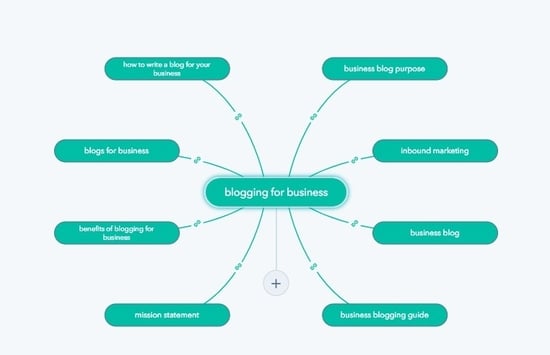
That core topic should be a broad term that is between 2-4 words in length, is industry specific, educational and supports your product or service. Ideally, it is educational so it relates to the awareness-stage of your prospect. Be sure to perform several Google searches on the term to determine what already exists.
Then, make a list of as many sub topics as possible that bring value to your core topic. If you haven't already created content relating to that subtopic, add it to your content calendar. Each subtopic needs to link back to the core topic.
In many ways, the pillar content page resembles a modified landing page since it includes an offer and conversion form. For each content pillar, make sure to:
Finally, you want to ensure that people can easily find your content pillar resources on your website. Be sure to include them as relevant to your:

You'll find other interesting content techniques worth exploring. For example, there's the skyscraper technique. With the skyscraper technique, you want to:
Ultimately, you're trying to create the best content possible about a specific topic.
Perhaps the most critical trend to pay attention to is also the most unglamorous one: ensuring that your content remains fresh and evergreen. Add to your content calendar and strategies sessions time to review already published content - webpages, blog articles, marketing automation emails and content offers - to ensure that they're up-to-date. Periodically updating blog articles means that you can unpublish and republish those articles with the latest information, adding to the relevance of your content.
Here's how to think of this process:
"Your content pillar is always under construction. Maintenance, updates, and additions are needed to keep it performing at a high level."
As you review your content, also make a point of checking for broken links, new resources, broken images and also image files that are too large. Compelling content includes a variety of visual formats, some of which can take up a long of bandwidth if not managed properly.
Be sure to check how your content looks on mobile as well as desktop. Mobile access has grown considerably. However, desktop access still matters for different reasons. Try to understand the differences so you can ensure the relevance of your content.
The more relevant and useful your website content is, the more it supports your business. The more compelling your storytelling, the more powerful your inbound content and the more successful your business will be.
Successful inbound marketing assumes that you regularly analyze results so you can make adjustments and improvements on an ongoing basis.
You must have available a tool for measuring your website performance and the performance on your marketing activities such as email, lead generation and blogging.
Be sure to integrate email with your analytics account and any other tools you use.
You may also have access to an all-in-one marketing automation solution such as HubSpot.
.jpg?width=500&name=Dashboard-twenty20_8892c947-f097-47f9-a922-a440782bb43c%20(650x433).jpg)
Ultimately, you're looking for patterns.
Understand and track how much traffic you have, how long it stays on your site, how many pages it explores, and which pages generate conversions. Compare it to past months and past years. Your business may have seasonal patterns. Understand them.
Learn where geographically your traffic is coming from, and whether visitors are at a desktop, a tablet or a mobile device. That matters if you'd like to offer certain categories of traffic a different experience (e.g., a different language for traffic coming from a different geography).
When you embrace analytics for your website, you begin to think of all of your online marketing activities and how they should integrate with one another to truly deliver on your SMART goals. For example, if you send out a regular email, how does that affect traffic to your site? Can it increase activity in a way that benefits your business?
Get into the habit of regularly running tests so you can learn how one type of headline works compared to another or one PPC ad versus another. Depending on the tools you use, you might run formal A/B tests, conduct surveys for insights to apply, experiment with different list segments and personalization or even try different visual tools. Experiments encourage you to ask questions and learn from the answers.

As you get started with inbound marketing, your first priority will be to start blogging regularly, to develop offers so you can convert visitors to leads and to develop nurturing sequences so those leads can eventually become customers.
Once you have several months of data, you can further prioritize. For example,
As you get into the detail behind your lead generation and conversion processes, you'll discover that:
Understanding the dynamics of your business will allow you to focus on the right levers so you can make sustainable improvements.
Wash. Rinse. Repeat. Every month.
Successful inbound marketing is more like a marathon than a sprint. You need to keep the momentum going for the long run. For that reason, it's important not to burn out. The more your entire organization embraces the inbound methodology, the easier you'll find keeping that momentum going.
.jpg?width=500&name=Open-24-twenty20_285d4d49-3155-4dc5-8f89-4b9b420a455b%20(600x400).jpg)
Technology can be helpful when you connect your marketing analytics with your sales and CRM (customer relationship management) systems, creating a closed loop ecosystem with data both groups can own.
And, keeping your organization up-to-speed on your website, blog and content offers combined with overall results on a regular basis through internal email newsletters not only encourages awareness, but also invites creativity.
The more relevant your marketing is to your business, the more contagious the commitment to quality and relevance to your customers.
Inbound marketing forces you to think about the entire journey your customer takes when doing business with you. When you consider the steps prospects take to become customers, you become aware of their questions and concerns and how to anticipate them with your content.
That's how to delight customers for life!


